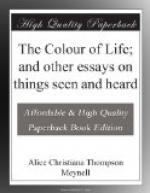Here, in North Wales, remote as the country is, with the wheat green over the blunt hill-tops, and the sky vibrating with larks, a long wing of smoke lies round the horizon. The country, rather thinly and languidly cultivated above, has a valuable sub-soil, and is burrowed with mines; the breath of pit and factory, out of sight, thickens the lower sky, and lies heavily over the sands of Dee. It leaves the upper blue clear and the head of Orion, but dims the flicker of Sirius and shortens the steady ray of the evening star. The people scattered about are not mining people, but half-hearted agriculturists, and very poor. Their cottages are rather cabins; not a tiled roof is in the country, but the slates have taken some beauty with time, having dips and dimples, and grass upon their edges. The walls are all thickly whitewashed, which is a pleasure to see. How willingly would one swish the harmless whitewash over more than half the colour—over all the chocolate and all the blue—with which the buildings of the world are stained! You could not wish for a better, simpler, or fresher harmony than whitewash makes with the slight sunshine and the bright grey of an English sky.
The grey-stone, grey-roofed monastery looks young in one sense—it is modern; and the friars look young in another—they are like their brothers of an earlier time. No one, except the journalists of yesterday, would spend upon them those tedious words, “quaint,” or “old world.” No such weary adjectives are spoken here, unless it be by the excursionists.
With large aprons tied over their brown habits, the Lay Brothers work upon their land, planting parsnips in rows, or tending a prosperous bee-farm. A young friar, who sang the High Mass yesterday, is gaily hanging the washed linen in the sun. A printing press, and a machine which slices turnips, are at work in an outhouse, and the yard thereby is guarded by a St Bernard, whose single evil deed was that under one of the obscure impulses of a dog’s heart—atoned for by long and self-conscious remorse—he bit the poet; and tried, says one of the friars, to make doggerel of him. The poet, too, lives at the monastery gates, and on monastery ground, in a seclusion which the tidings of the sequence of his editions hardly reaches. There is no disturbing renown to be got among the cabins of the Flintshire hills. Homeward, over the verge, from other valleys, his light figure flits at nightfall, like a moth.
To the coming and going of the friars, too, the village people have become well used, and the infrequent excursionists, for lack of intelligence and of any knowledge that would refer to history, look at them without obtrusive curiosity. It was only from a Salvation Army girl that you heard the brutal word of contempt. She had come to the place with some companions, and with them was trespassing, as she was welcome to do, within the monastery grounds. She stood, a figure




